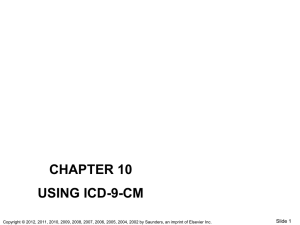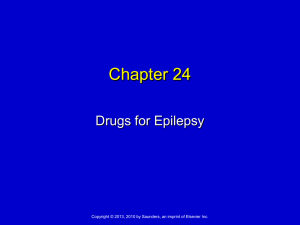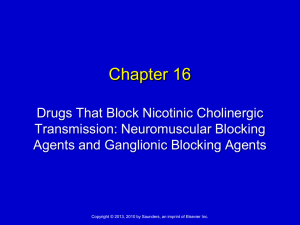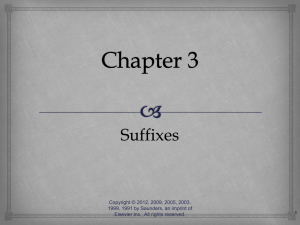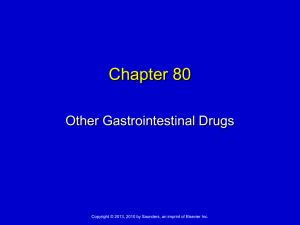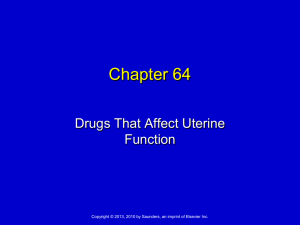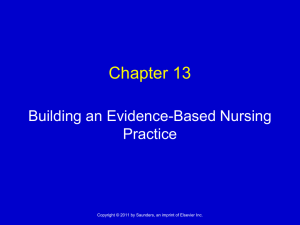Chapter 16 Cholinesterase Inhibitors
advertisement
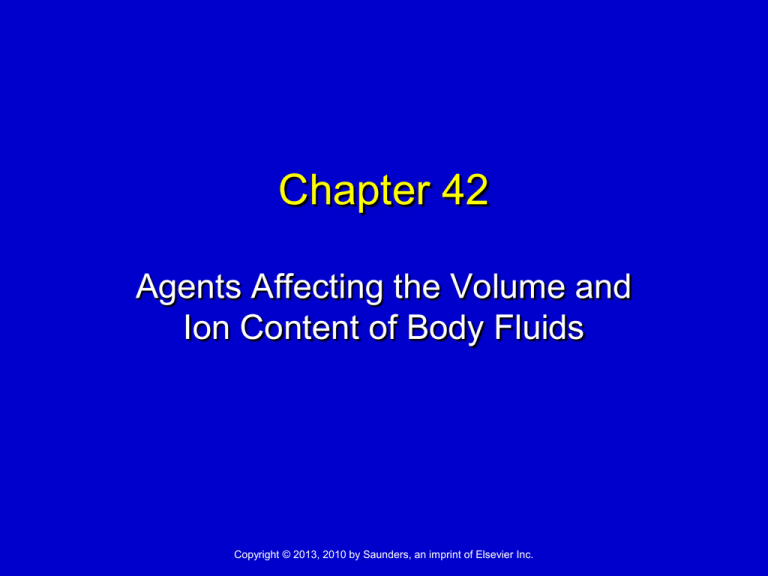
Chapter 42 Agents Affecting the Volume and Ion Content of Body Fluids Copyright © 2013, 2010 by Saunders, an imprint of Elsevier Inc. Drugs to Correct Disturbances Drugs used to correct disorders of fluid volume and osmolality Drugs used to correct disturbances of hydrogen ion concentration Drugs used to correct electrolyte imbalances Copyright © 2013, 2010 by Saunders, an imprint of Elsevier Inc. 2 Agents Affecting the Volume and Ion Content of Body Fluids Disorders of fluid volume and osmolality Acid-base disturbances Potassium imbalances Magnesium imbalances Copyright © 2013, 2010 by Saunders, an imprint of Elsevier Inc. 3 Fluid Volume and Osmolality Good health requires that both the volume and the osmolality of extracellular and intracellular fluids remain within a normal range Maintenance of both is primarily the job of the kidneys Volume contraction and volume expansion Copyright © 2013, 2010 by Saunders, an imprint of Elsevier Inc. 4 Volume Contraction and Volume Expansion Volume contraction Decrease in total body water Definition, causes, and treatment • Isotonic, hypertonic, and hypotonic Volume expansion Increase in total body water Definition, causes, and treatment • Isotonic, hypertonic, and hypotonic Copyright © 2013, 2010 by Saunders, an imprint of Elsevier Inc. 5 Isotonic Contraction Definition Causes Volume contraction in which sodium and water are lost in isotonic proportions Decrease in total volume, but no change in osmolality Vomiting, diarrhea, kidney disease, and misuse of diuretics Treatment Fluids that are isotonic to plasma 0.9% NS Replenish slowly to prevent pulmonary edema Copyright © 2013, 2010 by Saunders, an imprint of Elsevier Inc. 6 Hypertonic Contraction Definition Causes Loss of water exceeds loss of sodium Reduced extracellular fluid volume and increase in osmolality Excessive sweating, osmotic diuresis, concentrated food given to infants Secondary to extensive burns or CNS disorders that interfere with thirst Treatment Hypotonic fluids or fluids that contain no solutes at all (D5W) Initial therapy: drink water Copyright © 2013, 2010 by Saunders, an imprint of Elsevier Inc. 7 Hypotonic Contraction Definition Causes Loss of sodium exceeds loss of water Both volume and osmolality of extracellular fluid are reduced Excessive loss of sodium through the kidney (diuretic therapy, chronic renal insufficiency, lack of aldosterone) Treatment Mild: infusing isotonic sodium chloride solution for injection Severe: hypertonic solution (3%) NaCl Watch for signs of fluid overload Copyright © 2013, 2010 by Saunders, an imprint of Elsevier Inc. 8 Volume Expansion Definition Causes Increase in the total volume of body fluid May be isotonic, hypertonic, hypotonic Overdose with therapeutic fluids Disease states (congestive heart failure [CHF], nephrotic syndrome, cirrhosis with ascites) Treatment Diuretics Agents used for heart failure Copyright © 2013, 2010 by Saunders, an imprint of Elsevier Inc. 9 Acid-Base Disturbances Acid-base balance is maintained by multiple systems Bicarbonate–carbonic acid buffer system Respiratory system • CO2 (increase lowers pH) Kidneys • HCO3– (increase raises pH) Copyright © 2013, 2010 by Saunders, an imprint of Elsevier Inc. 10 Acid-Base Disturbances Respiratory alkalosis Respiratory acidosis Metabolic alkalosis Metabolic acidosis Copyright © 2013, 2010 by Saunders, an imprint of Elsevier Inc. 11 Respiratory Alkalosis Causes Hyperventilation causes decrease in CO2 Treatment Mild: none needed More severe: rebreathe CO2-laden expired breath Copyright © 2013, 2010 by Saunders, an imprint of Elsevier Inc. 12 Respiratory Acidosis Causes Retention of CO2 secondary to hypoventilation • Depression of the medullary respiratory center • Pathologic changes in the lungs Treatment Correction of respiratory impairment Infusion of sodium bicarbonate if severe Copyright © 2013, 2010 by Saunders, an imprint of Elsevier Inc. 13 Metabolic Alkalosis Causes Excessive loss of gastric acid Administration of alkalinizing salts Treatment Solution of sodium chloride plus potassium chloride Copyright © 2013, 2010 by Saunders, an imprint of Elsevier Inc. 14 Metabolic Acidosis Causes Chronic renal failure Loss of bicarbonate during severe diarrhea Metabolic disorders Poisoning by methanol and certain medications Treatment Correction of the underlying cause of acidosis Alkalinizing salt if severe Copyright © 2013, 2010 by Saunders, an imprint of Elsevier Inc. 15 Potassium Most abundant intracellular cation Extracellular concentrations are low Major role in: Conducting nerve impulses Maintaining the electrical excitability of muscle Regulating acid-base balance Copyright © 2013, 2010 by Saunders, an imprint of Elsevier Inc. 16 Regulation of Potassium Levels Primarily by the kidneys Renal excretion increased by aldosterone Excretion also increased by most diuretics Potassium-sparing diuretics are the exception Influenced by extracellular pH Alkalosis potassium uptake enhanced Acidosis potassium exits cells Insulin has a profound effect on potassium level Copyright © 2013, 2010 by Saunders, an imprint of Elsevier Inc. 17 Hypokalemia Serum potassium levels less than 3.5 mEq/L Causes and consequences Most common cause is treatment with a thiazide or loop diuretic • Less common: excessive insulin, alkalosis Adverse effects on skeletal muscle, smooth muscle, blood pressure, and the heart Hypokalemia increases the risk for hypertension and stroke Copyright © 2013, 2010 by Saunders, an imprint of Elsevier Inc. 18 Hypokalemia Treatment Potassium salts preferred because chloride deficiency frequently coexists with hypokalemia Oral potassium chloride: mild • Sustained-release version has fewer GI effects • Abdominal discomfort, nausea and vomiting, diarrhea IV potassium chloride: severe or cannot take PO • Must be diluted and infused slowly Copyright © 2013, 2010 by Saunders, an imprint of Elsevier Inc. 19 Hypokalemia Treatment Contraindications to potassium use Avoid in patients who are predisposed to hyperkalemia • Severe renal impairment, use of potassium-sparing diuretics, hypoaldosteronism Principal complication of hypokalemia is hyperkalemia Assess renal function and changes in ECG ECG = electrocardiogram. Copyright © 2013, 2010 by Saunders, an imprint of Elsevier Inc. 20 Hyperkalemia Excessive elevation of serum potassium Causes • Severe tissue trauma • Untreated Addison’s disease • Acute acidosis (draws K out of cells) • Misuse of potassium-sparing diuretics • Overdose with IV potassium Copyright © 2013, 2010 by Saunders, an imprint of Elsevier Inc. 21 Hyperkalemia Consequences Disruption of the electrical activity of the heart Earliest sign patient is in danger • Mild elevation (5–7): T wave heightens; PR prolonged • Severe elevation (8–9): cardiac arrest can occur Noncardiac signs • Confusion, anxiety, dyspnea, weakness or heaviness of legs, numbness/tingling of hands/feet/lips Copyright © 2013, 2010 by Saunders, an imprint of Elsevier Inc. 22 Hyperkalemia Treatment Withhold foods that contain potassium Withhold medicines that promote potassium accumulation Counteract potassium-induced cardiotoxicity Lower extracellular levels of potassium • Calcium gluconate • Infusion of glucose and insulin • If acidotic: infusion of sodium bicarbonate Copyright © 2013, 2010 by Saunders, an imprint of Elsevier Inc. 23 Magnesium Required for the activity of many enzymes Binding of messenger RNA to ribosomes Copyright © 2013, 2010 by Saunders, an imprint of Elsevier Inc. 24 Magnesium Imbalances Hypomagnesemia Causes • Diarrhea • Hemodialysis • Kidney disease • Prolonged intravenous feeding • Chronic alcoholism • Hypermagnesemia Prevention and treatment • Magnesium gluconate and magnesium hydroxide • Magnesium sulfate Copyright © 2013, 2010 by Saunders, an imprint of Elsevier Inc. 25 Magnesium Imbalances Hypermagnesemia Most common in patients with renal insufficiency Copyright © 2013, 2010 by Saunders, an imprint of Elsevier Inc. 26
